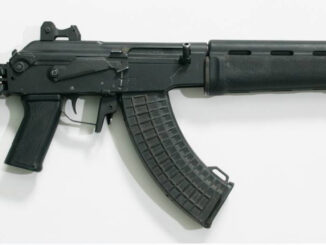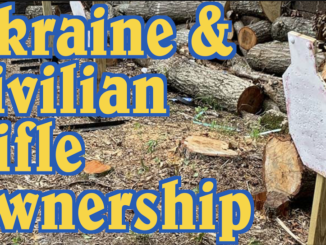Carl Pelo was a an engineer with Sako in the 1930s, and developed a series of self-loading rifles. He used a short recoil mechanism with a pair of locking flaps on the bolt, much like the Degtyarev machine guns from the Soviet Union. Pelo attempted to market his design both to the Finnish armed forces as well as the UK and Sweden, but was unable to get any interest (in Finland, this appears to have been largely the result of trying to sidestep standard military procurement channels by appealing directly to civil government authorities).
Prior to the Winter War, the Finnish Army was short on funds and did not see the value in trying to adopt a self-loading standard infantry rifle, but this opinion changed by 1940. There was not nearly enough time to develop Pelo’s rifles between the Winter War and Continuation War, but by the early 1950s the Army was willing to give the gun a real chance. It performed surprisingly well in testing, but was ultimately rejected for its cartridge. The Finnish test rifles were chambered for 7.62x54R (53R in Finnish usage), and in Swedish testing 6.5x55mm. Finland decided to adopt a rifle in 7.62x39mm instead, and this made Pelo’s design moot. While testing and iterations on the design continued through the 1950s (the model in today’s video is a 1954 pattern), nothing was ever put into production and surviving examples are very scarce.
Thanks to Sako for giving me access to film this one from their factory museum!
For a bunch of photos and an English-language report on the 6.5mm Pelo, see my full Pelo rifle page:
https://www.forgottenweapons.com/rifles/finnish-pelo-rifle/




No markings? OH< MY GOD! IT'S A GHOST GUN!! SOMEBODY NOTIFY THE FBI!!!
Uh, the gun’s in Finland, where the FBI has no jurisdiction …
It’s a joke, like the FBI.
You’ve never heard of the Finnish Bureau of Investigation?
Well it is a prototype, so it would not have production markings. Plus, it’s only a ghost gun if you were to sell it on the commercial market as-is. The museum clearly said it’s not for sale, and that item is certainly not going to America!
Please do not use anti gun terminology. G.g. is just such nonsense. Why not “phantom gun” ? etc.
Umm… a phantom is a ghost.
I used “GG” because that’s what an anti-firearms type would be screaming – it’s for comic effect
Beware the LAW OF POE https://en.wikipedia.org/wiki/Poe%27s_law
Comments here are devolving to youtube lows?
This looks to me as the most rudimentary (in terms of conception) short recoil rifle mechanism. I relies on barrel being held(latched) in the rear till action re-engages it. Then whole group moves forward to fire-ready position. It entails design complexity and potentially lack of reliability. To achieve this with given type of lock-up in other way is practically impossible.
Much preferred is a system whereby the barrel returns forward on its accord (without latching) while bolt is engaging it in rotary motion. Yes, I am talking Johnson M 1940 rifle system. Interestingly, neither one of them took full advantage of primary masses momentum, although it can be argued the Johnson’s bolt is somewhat ‘accelerated’ during its unlocking.
In my awareness there was one rifle of that type (using accelerator) which was designed by Leonard Browning, cousin of J. M. Browning. Leonard applied John’s previously tried accelerator idea used on his machine-guns. We saw it on FW couple of years ago. Unfortunately this design did not come to fruition and in flow of time disappeared. It is time for someone to take another “go” at it. There is a benefit to be gained.
“I relies on barrel…” should read:
“It relies on barrel…”
“(…)Johnson M 1940 rifle system(…)”
What is that in what way it differ from Johnson 1941
http://modernfirearms.net/en/military-rifles/self-loading-rifles/u-s-a-self-loading-rifles/m1941-johnson-eng/
?
Read what I wrote: the Barrel on Johnson does NOT have to be held(latched) back to meet action on their joint travel forward. I consider this Finnish attempt an anachronism and it is clear to me why it was not adopted.
Certainly anachronistic in the 1950s, but let’s not forget that the basic design was from the 1930s. That said, Captain Pelo tried to make up with enthusiasm what he lacked in talent. He was a competent engineer, but had not been gifted with the kind of talent that separated the “big names” of gun design from the merely competent.
On the other hand, even if the rifle had been equal to the likes of Garand, it would have made no difference once the Finnish Army had had its first taste of the AK and its intermediate cartridge. The impact was such that there simply was no way the Army would have adopted a full power rifle cartridge semi-auto rifle after that.
I would definitely NOT discount kapt. Pelo’s enthusiasm. Also a superb level of confidence in his capabilities, given letters to high positions. As far as “talent”, I leave any comments out.
But, you know wat? It is often the “firm head” which prevails.
“He was a competent engineer, but had not been gifted with the kind of talent that separated the “big names” of gun design from the merely competent.”
Independently from that, for me it see that Pelo was… just out of luck regarding getting his development in right place and right time.
In 1930s Finland has more pressing needs regarding infantry weapons, e.g. light machine guns (as witnessed by wide usage of captured DP machine guns during war), so I doubt they will be willing to encumber themselves with replacing Mosin repeating rifle with any self-loading rifle of domestic production.
Continuing Pelo also developed light machine gun, see chapter Light machinegun prototypes of Carl Pelo: in http://www.jaegerplatoon.net/ALMOST1.htm
Summing up when Pelo tried to improve his design Lahti-Saloranta was officially adopted and factory set-up for it started. It proved impossible to make this design so much better to make reasonable switch to it.
And also developed compact sub-machine gun, see chapter Submachine guns of Carl Pelo: in http://www.jaegerplatoon.net/ALMOST2.htm
It did predated what was called PDW (during Cold War) and was something what Finnish forces (1940s) have not money for.
“Read what I wrote(…)”
I formulated question unfortunately: I must first know difference between “Johnson M 1940 rifle system” AND Johnson 1941.
Why do you prefer “a system whereby the barrel returns forward on its accord”?
At worst, a “latching” system requires 2-3 simple parts (latch, spring, maybe a pivot pin). At best (as in practically all autopistols today) intentional interference of the parts themselves keeps the barrel rearward. In return, you get intuitive breech design (a simple ramp that presents itself to the magazine rather than having to recoil over the bullets / mag lips and back) as well as simplicity (similar to gas-operated rifles) in keeping the bolt out of battery, using the unlocking surfaces plus a basic rail or rod.
I make it brief for you Mike.
It is not a ‘preference’ per se, it is part of my OWN experience. I was playing with similar ideas in mid 1980s (let’s remember there was NO internet that time). It was time I was interested in “softer action” rifle mechanism. I came rather quickly to conclusion this (latching barrel back) was the WRONG way of doing it. When I looked later closely at Johnson rifle it was pretty clear to me.
Oh yeah, and drawings were made on board with pencil and erasing shield. That was the time to practice one’s visualization 🙂
Looks Teutonic in nature. Very well machined and somewhat overly complicated. They were against drilling holes in barrels for gas ports at the time as well. I wonder if he tried peddling this design elsewhere?
“(…)I wonder if he tried peddling this design elsewhere?”
During WW2 yes, according to http://www.jaegerplatoon.net/ALMOST1.htm
Carl Pelo tried selling his automatic rifle designs also in Sweden and Norway and moved to Sweden before World War 2. Year 1940 he offered his weapon designs to Swedish (Eskilstuna) and Norwegian (Kongsberg) factories, but without success. When Swedish Armed Forces tested semi-automatic rifles year 1941 also his prototypes were among those tested, but lost to Ljungman design, which became automatgevär m/42 (automatic rifle m/42) of Swedish Army. In these Swedish tests the main handicap of Pelo’s design seem to have been manufacturing costs, which were considered too high.
Indeed. Certainly overly complicated…
OFF-TOPIC SO IGNORE IF YOU WISH
https://www.thefirearmblog.com/blog/2019/09/07/true-velocity-composite-cased-ammo-ngsw/
claims that
True Velocity’s proprietary 6.8mm case design will provide end users with significant logistical and operational advantages over traditional brass-cased ammunition, including substantially increased effective range and muzzle energy, drastic reduction in cartridge weight and enhanced accuracy. The combination of True Velocity’s ammunition with the General Dynamics OTS weapon submission results in a state-of-the-art weapon system capable of long-range lethality, short recoil impulse, significant ballistic improvements and enhanced operational effectiveness for the soldier.
But what short recoil impulse is? Or alternatively when recoil impulse (not recoil itself) is short and when long?
The 6.8mm Rifle and LSW of new breed by GD are NOT recoil operated; they are operated by gas. However in an attempt to deal with substantial firing impulse (greater than 7.62 NATO), the entire barrel w/ receiver and action are allowed to recoil inside of outer envelope. They are arrested against an internal buffer. Same idea is applied on company’s medium-heavy machinegun.
“(…)a pair of locking flaps on the bolt, much like the Degtyarev machine guns from the Soviet Union.(…)”
He also created self-loading rifle with such flaps, albeit it was gas-operated.
See images https://memo-randum.net/katalog/ognestrelnoe-oruzhie/karabiny/7-62-mm-samozaryadnaya-vintovka-degtyareva-obr-1930-g7702/
it was adopted to service but proved catastrophe reliability-wise (getting from working prototype to working mass production proved not easy) so fall into oblivion of history
Let’s think about it: when you have pair of locking flappers, they should engage recesses in receiver exactly at the same time (be of same length). If they do not, one of them is loaded more and it may produce faster wear or even fail. If you can make both flappers exactly the same, let’s say from one bar sliced up to individual parts you can achieve it quite easily. The remaining part of task is to make locking recesses in receiver at the same distance from the barrel’s breech end.
I thought you said there was a 25% chance of jamming or trigger sear failure…
the sights look very good. other clips then the mosin? but where is the safety on the thing? 50s. semi battle rifles when the ak and fal came on the market became outgunned rather fast.
“(…)50s. semi battle rifles when the ak and fal came on the market became outgunned rather fast.”
Yes, but in this time SAFN-49 found buyers http://modernfirearms.net/en/military-rifles/self-loading-rifles/belgium-self-loading-rifles/fn-safn-49-eng/
Yes, that is a fact, but Monsieur Saive’s rifle was much more mature than Pelo’s when FN started to produce it. Besides, FN had decades of experience exporting weapons by then. It was hard to compete against such an well oiled and established company.
“…a pair of locking flaps on the bolt, much like the Degtyarev machine guns from the Soviet Union…”(С)
I hope this does not mean “the Degtyarev system served as a prototype”?
Degtyarev’s system had nothing to do with this.
It is a synthesis from the Mauser and Braeuning systems.
By the way, Degtyarev and Pelo drew from one well.
https://delcampe-static.net/img_large/auction/000/227/906/132_002.jpg
https://patentimages.storage.googleapis.com/52/14/1f/6410bb2787af9d/US884065-drawings-page-1.png
Do as you wish, for me DP locking mechanism bears semblance to Kulsprutegevaer Fm/Kjellman
http://www.gotavapen.se/gota/artiklar/kg/swedish_kg1.htm
I do not intend to spread talk beyond original intention. However, just saw on H&R Arsenal the Swiss Mannlicher 1893 carbine. Everyone should see this as a demonstration how good idea can go wrong. That thing was nearly impossible to service; to disassemble the action to clean and put it back together was a royal pain. Something which no soldier should get to his hands, ever.
https://www.youtube.com/watch?v=5LxioKzhLIE
Besides, FN had been selling guns for decades at the time. It was difficult to compete with such a well-oiled and well-established organization.